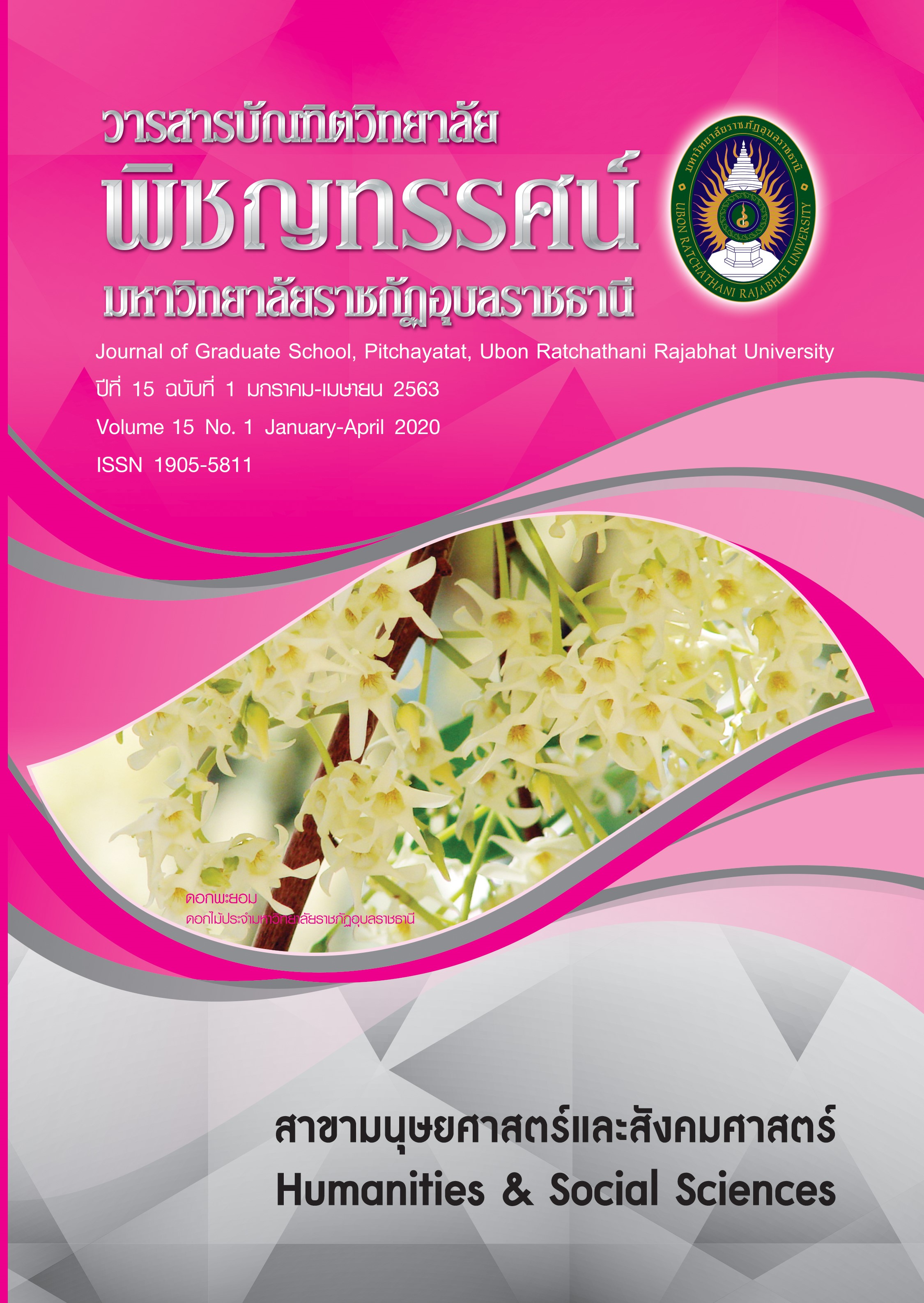การพัฒนาผลิตภัณฑ์สู่ Premium OTOP ด้วยทุนทางวัฒนธรรมและภูมิปัญญาท้องถิ่น กรณีผ้าไหมย้อมสีธรรมชาติของกลุ่มสตรีทอผ้าบ้านหัวเมือง อ.มหาชนะชัย จ.ยโสธร
คำสำคัญ:
การพัฒนาผลิตภัณฑ์, ผ้าไหมย้อมสีธรรมชาติ, ทุนวัฒนธรรม, ภูมิปัญญาท้องถิ่นบทคัดย่อ
การวิจัยนี้มีวัตถุประสงค์เพื่อสำรวจตลาดเกี่ยวกับความนิยมในสีธรรมชาติและรูปแบบของผลิตภัณฑ์ และพัฒนาผลิตภัณฑ์ผ้าไหมย้อมสีธรรมชาติสู่ Premium OTOP ด้วยทุนทางวัฒนธรรมและภูมิปัญญาท้องถิ่น ของกลุ่มสตรีทอผ้าบ้านหัวเมือง อ.มหาชนะชัย จ.ยโสธร โดยมีขั้นตอนในการวิจัยแบ่งเป็น 2 ระยะ คือระยะแรกเป็นการสำรวจตลาดเกี่ยวกับความนิยมในสีธรรมชาติและความต้องการในรูปแบบของผลิตภัณฑ์ ตัวอย่างได้แก่ผู้ที่อยู่ในวัยทำงานจำนวน 520 คน โดยสุ่มตัวอย่างแบบบังเอิญจากประชาชนที่มาจับจ่ายใช้สอยในงานแสดงสินค้า สถิติที่ใช้ได้แก่ ร้อยละ ค่าเฉลี่ย และส่วนเบี่ยงเบนมาตรฐาน ส่วนระยะที่สองเป็นการพัฒนาผลิตภัณฑ์ ตัวอย่างได้แก่ สมาชิกกลุ่มสตรีทอผ้าบ้านหัวเมืองจำนวน 77 คน มีขั้นตอนการพัฒนาตั้งแต่การออกแบบลวดลาย การย้อมสีธรรมชาติ การทอผ้า และการพัฒนาผลิตภัณฑ์ตามความต้องการของตลาด
ผลการวิจัยพบว่า
- แนวทางการพัฒนาผลิตภัณฑ์ต้องให้ความสำคัญกับการเน้นการเลือกวัตถุดิบและเส้นไหมที่มีคุณภาพและโทนสีที่นิยม ได้แก่ สีที่บ่งบอกความสมดุลของธรรมชาติ ประกอบด้วยโทนสีม่วง สีชมพู สีน้ำตาล และสีฟ้าอ่อน
- ผลผลิตภัณฑ์ของกลุ่มสตรีทอผ้าบ้านหัวเมือง ได้แก่ ผ้าไหมย้อมสีธรรมชาติ ชุดสตรี เครื่องใช้และของประดับตกแต่ง
เอกสารอ้างอิง
จังหวัดยโสธร, สำนักงาน. ยุทธศาสตร์การพัฒนาจังหวัดยโสธร. (ออนไลน์) 2562 (4 พฤษภาคม 2562).จาก http://www.yasothon.go.th/web/manage/manage1.html
ชัยประนิน วิสุทธิผล. คุณค่าของเอเชีย เทรนด์ใหม่ที่โลกกำลังเดินตาม ทำไมต้องเศรษฐกิจสร้างสรรค์: รวมบทความกระตุ้นอะดรีนาลิน โดย 6 นักคิด. กรุงเทพฯ: ศูนย์สร้างสรรค์งานออกแบบ, 2552.
นายกรัฐมนตรี, สำนัก. แผนพัฒนาเศรษฐกิจและสังคมแห่งชาติฉบับที่ 12. (ออนไลน์) 2559 (2 กุมภาพันธ์ 2559). จากhttps://www.nesdb.go.th/ewt_dl_link.php?nid=6422
บุญชม ศรีสะอาด. การวิจัยเบื้องต้น. พิมพ์ครั้งที่ 8. กรุงเทพฯ: สุริยสานส์, 2553.
Cheng, S. “Cultural goods creation, cultural capital formation,provision of cultural services and cultural atmosphere accumulation,” Journal of Cultural Economics. 30, 4 (2006): 263-286.
Dennis Campbell, Frabces X.Frei and Ryan W.Buell. How do customers respond to
increased service quality competition?. Accounting & Management Unit Working: Harvard Business School, 2016.
Rudrajeet, Pal. “Sustainable Design and Business Model in Textile and Fashion Industry,” Part of the Textile Science and Clothing Technology book series. 11, 24 (2016): 109-138.
Sojin Jung and Byoungho Jin. “Sustainable Development of Slow Fashion Business: Customer Value Approach,” MDPI journal. 8, 6 (2016):1-15
ดาวน์โหลด
เผยแพร่แล้ว
รูปแบบการอ้างอิง
ฉบับ
ประเภทบทความ
สัญญาอนุญาต
บทความทุกเรื่องได้รับการตรวจความถูกต้องทางวิชาการโดยผู้ทรงคุณวุฒิภายนอกอย่างน้อย 3 คน ความคิดเห็นในวารสารพิชญทรรศน์เป็นความคิดเห็นของผู้นิพนธ์มิใช่ความคิดเห็นของผู้จัดทำ จึงมิใช่ความรับผิดชอบของวารสารพิชญทรรศน์ และบทความในวารสารพิชญทรรศน์สงวนสิทธิ์ตามกฎหมายไทย การจะนำไปเผยแพร่ต้องได้รับอนุญาตเป็นลายลักษณ์อักษรจากกองบรรณาธิการ





